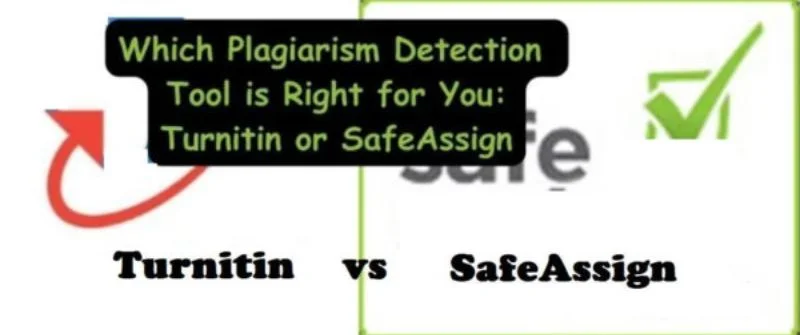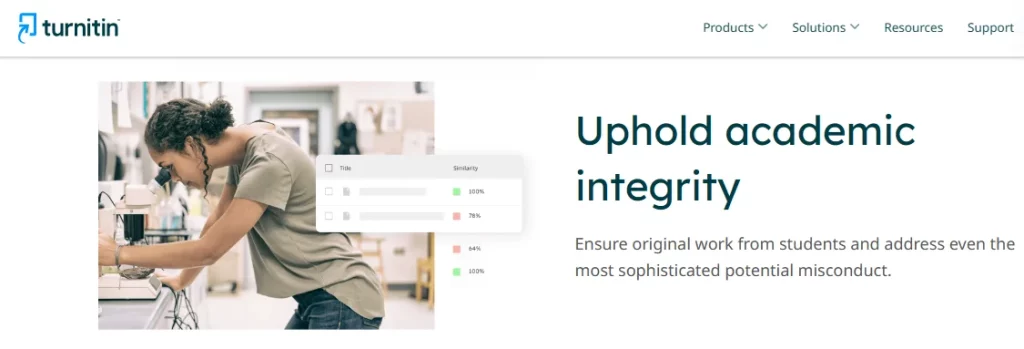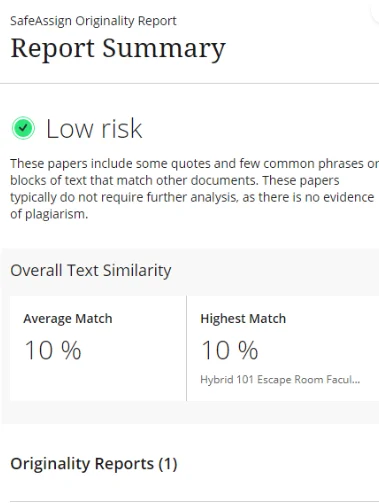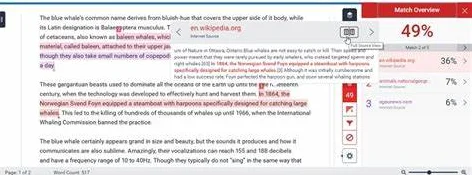Turnitin or SafeAssign: Which Plagiarism Detection Tool is Right for You?

Plagiarism detection technologies are essential for ensuring academic honesty and originality in written tasks. Turnitin and SafeAssign are two well-liked solutions extensively employed in educational institutions.
Both systems compare submitted documents to a vast database of sources to detect plagiarism. Each instrument does, however, have particular characteristics and capabilities.
This post will compare and contrast Turnitin and SafeAssign so that you may choose the plagiarism detection program that is best for your requirements.
Which Plagiarism Detection Tool is Right for You?
1. Considerations for Educators

Here are a few considerations for educators:
Integration and Compatibility
Determine the tool’s compatibility with your institution’s learning management system (LMS).
Some LMS platforms have built-in integration with specific plagiarism detection tools, simplifying the process for educators and students.
User Feedback and Reputation
Research and gather feedback from other educators who have used SafeAssign and Turnitin. Consider user reviews and testimonials to gauge each tool’s overall satisfaction and reliability.
Database Size and Coverage
Assess the size and comprehensiveness of each tool’s database to check for similarities. A more extensive database with diverse sources improves the accuracy of plagiarism detection.
Originality Reports
Look for features that provide detailed originality reports. These reports should highlight matched sources, display similarity percentages, and offer insights into the matches found (e.g., direct quotes or paraphrased content).
Customization and Flexibility
Consider the level of customization offered by the tool. Educators may require options to set specific parameters, exclude certain sources (such as bibliographic material or common phrases), or customize settings to align with institutional policies.
User-Friendly Interface
Evaluate the usability and interface of the tool. An intuitive and user-friendly design can simplify the process for educators and students, making navigating and interpreting the results more accessible.
People Also Read: Free Answer Websites: 7 Alternatives to Chegg or Course Hero
2. Considerations for Students
SafeAssign and Turnitin play a vital role in promoting academic integrity by identifying plagiarism and supporting a culture of originality and proper citation.

SafeAssign, integrated into Blackboard, offers a convenient solution for institutions using this LMS.
Turnitin, known for its extensive database and advanced features, provides a comprehensive plagiarism detection experience.
Both tools assist in educating students about the importance of citing sources and maintaining academic honesty, ultimately ensuring the integrity of their work and the academic community as a whole.
Considerations for students when deciding which plagiarism detection tool to use are crucial for their academic success. Here are some factors to address:
Ease of Use
Evaluate the user interface and functionality of both SafeAssign and Turnitin. Consider which tool offers a more intuitive and user-friendly experience for students.
Accessibility
Determine the availability and accessibility of the tools across different devices and operating systems.
More importantly, assess whether students can easily submit their assignments and access the plagiarism reports.
Support Resources
Look into the support resources provided by each tool, such as tutorials, FAQs, or customer support. Also, consider which device offers comprehensive resources to help students understand the results and address concerns.
People Also Read: Sources of Free Essays Online: Where to Get Free Good Essays
Importance of Plagiarism Detection Tools in Academic Institutions
1. Ensuring Academic Integrity
Plagiarism detection tools are crucial for upholding academic integrity by identifying instances of plagiarism. Furthermore, they promote fair evaluation of students’ work, ensuring originality and proper citation are upheld.
2. Preventing Intellectual Dishonesty
By comparing submitted assignments against extensive databases of academic sources, these tools help prevent intellectual dishonesty. They discourage students from copying or misrepresenting others’ work as their own.
3. Encouraging Ethical Writing Practices
Plagiarism detection tools educate students about the importance of ethical writing practices, including proper citation and referencing. Such ethics emphasize the value of originality and encourage students to develop their research and writing skills.
Understanding Plagiarism Detection Tools
Passing off someone else’s ideas, works, or words as one’s own without giving due credit or recognition is known as plagiarism.

It is a major academic violation because it violates the values of originality, intellectual honesty, and academic integrity.
More importantly, by misrepresenting the plagiarist’s knowledge, skills, and effort, plagiarism deceives readers or assessors.
It is unethical, prevents the growth of research and critical thinking skills, and damages both the person’s and the academic community’s credibility and reputation.
Remarkably, plagiarism detection techniques are essential to detect and avoid plagiarism, provide fair evaluation, and respect educational objectives.
Plagiarism detection tools spot instances of plagiarism in academic writing.
To find similarities and possible instances of plagiarism, these programs evaluate submitted content against vast databases of scholarly sources, online publications, and other documents.
These techniques help to promote academic integrity to discourage and avoid intellectual dishonesty.
They support correct citation and reference, promote honesty and ethical writing practices, and aid educators and institutions in upholding high standards of originality.
The values of academic integrity are upheld by using plagiarism detection techniques, and fair evaluation of student work is ensured.
People Also Read: Lying on College Essay: Causes, Tips and The Consequences
How Plagiarism Detection Tools Work
SafeAssign Algorithm
SafeAssign, integrated into Blackboard, uses a sophisticated algorithm to identify potential instances of plagiarism. The process involves the following steps:
- SafeAssign compares the submitted document against a vast database of academic papers, internet sources, and previously submitted assignments.
- Furthermore, the algorithm analyzes the text and generates an Originality Report highlighting any matching or similar content.
- Lastly, SafeAssign assigns a similarity index, indicating the percentage of matching content in the submitted work.
Turnitin Algorithm
Turnitin employs an advanced algorithm to detect plagiarism. The procedure includes the following steps:

Students submit their assignments to Turnitin through the platform’s interface. In addition, Turnitin indexes the submitted document, creating a digital fingerprint based on the document’s text and structure.
The algorithm compares the fingerprint of the submitted document against its extensive database, consisting of published works, academic papers, and other sources.
Turnitin generates an Originality Report, highlighting any matching content and providing detailed information about the sources. Remarkably, the algorithm assigns a similarity score, indicating the percentage of matching content in the submitted work.
The Process of Submitting Papers and Generating Similarity Reports
Students and teachers can assess the originality of academic works by submitting papers and generating similarity reports with SafeAssign and Turnitin. These reports are valuable resources for spotting possible plagiarism and advancing academic honesty.
Teachers can make informed assessments while advising students on proper citation and reference techniques by giving students detailed information about how material and sources match up.
Here is the process for submitting papers and generating reports:
People Also Read: 7 reasons why Writing is Important in College & in Life
SafeAssign
The process of submitting papers and generating similarity reports through SafeAssign involves the following steps:
- Students submit their papers through the Blackboard learning management system incorporating SafeAssign.
- SafeAssign indexes the submitted papers, creating a digital fingerprint based on the text and structure of the document.
- The indexed paper is compared against a vast database that includes previously submitted documents, academic sources, and internet content.
- SafeAssign generates an Originality Report highlighting the submitted paper’s matching or similar content.
- The Originality Report provides a similarity index, indicating the percentage of matching or similar content in the submitted paper.
- Students and educators can review the Originality Report to identify specific instances of matching content and evaluate the overall originality of the paper.
Turnitin
Submitting papers and generating similarity reports with Turnitin follows a similar process, as outlined below.
- Students submit their papers through the Turnitin platform, directly or integrated within their institution’s learning management system.
- Turnitin indexes the submitted papers, creating a unique digital fingerprint based on the content and structure of the document.
- The indexed paper is compared against Turnitin’s extensive database, which includes published works, academic sources, and previously submitted papers.
- Turnitin generates an Originality Report that provides a detailed analysis of matching or similar content in the submitted paper.
- The Originality Report includes a similarity score, indicating the percentage of matching or similar content detected in the submitted paper.
- Students and educators can access the Originality Report to review the highlighted instances of matching content, view the sources, and assess the overall originality of the paper.

Josh Jasen or JJ as we fondly call him, is a senior academic editor at Grade Bees in charge of the writing department. When not managing complex essays and academic writing tasks, Josh is busy advising students on how to pass assignments. In his spare time, he loves playing football or walking with his dog around the park.




